“Everything begins with an idea,” Earl Nightingale says, and he’s right. You began your business with an idea, earned your first income with an idea, and took your business to the next level with an idea.
Ideas are what keep businesses alive, which is why brainstorming ideas is such an important part of running a business.
In this post, we will discuss and learn everything there is to know about brainstorming ideas, from beginning to end, including what it is, why it is important, its techniques, tools, and everything else.
So let’s get started.
What is brainstorming?
Before we dig deeper into it, let us first understand what brainstorming is.
Here you go:
To explain it in simple words, brainstorming is a session where a group of people gathers around to discuss ideas and solutions on a topic. You can share ideas, thoughts, opinions, or any other kind of important information that helps you achieve your brainstorming goal.
Typically, brainstorming sessions are held to either bring out new ideas or solve an existing business problem.
Benefits and importance of brainstorming
Basically, brainstorming is all about coming up with as many ideas as possible without worrying about them being good or bad. It can significantly help you solve any kind of business problem.
Here are a few reasons why brainstorming is important for a business:
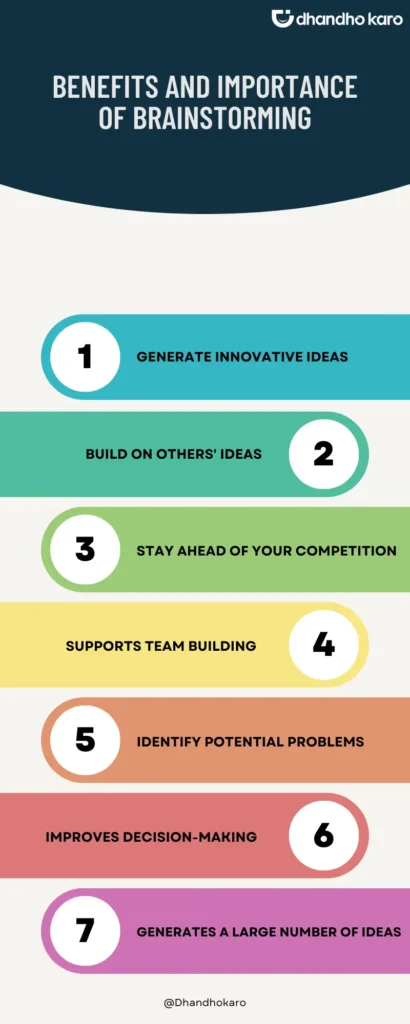
1. Generate innovative ideas
A brainstorming session is when a group of people gets together to discuss a specific topic in order to generate new ideas.
This way, everyone has an equal opportunity to open their minds and share any ideas that come to them. Such brainstorming sessions frequently lead to the creation of numerous innovative ideas that are both new and beneficial to the business.
2. Build on others’ ideas
As the saying goes, “one plus one equals three,” and brainstorming sessions are no different.
When you brainstorm ideas with a group of people, you have the opportunity to build on the ideas of others. After each person has shared their ideas, the team can take a few of them and combine them to expand on them and generate even better ideas.
3. Stay ahead of your competition
It is crucial for every business to do its best to stay ahead of their competitions. Brainstorming can be a good go-ahead here.
Brainstorming sessions help businesses in differentiating themselves from competitors by solving problems in an efficient manner. You can hold a brainstorming session to better understand your customers’ needs and desires, and then decide how your business can address them in order to stand out in the market.
Whatever you use it for, brainstorming is one of the best ways to stay ahead of the competition.
4. Supports team building
Brainstorming is not an activity that can be completed by a single person. An effective brainstorming session requires you to gather your team and discuss new ideas with them. This allows each individual to share their ideas and express themselves, which boosts their morale.
Additionally, brainstorming sessions enable individuals to collaborate and work on a specific problem with their team. This strengthens each individual’s relationships and teaches them how to work as a team.
5. Identify potential problems
Brainstorming sessions help businesses identify potential problems or roadblocks that they wouldn’t have realized otherwise. This is because brainstorming discussions can lead a team from one point to another, causing them to realize what potential problems an idea may face.
6. Improves decision-making
Brainstorming is an activity where you gather around a group of people and throw out your ideas in order to participate. This leads each Individual to think more critically and focus heavily on making effective decisions as they might get different opinions from different people with different perspectives.
7. Generates a large number of ideas
When brainstorming, it is always recommended to conduct it with a group of people. This helps businesses to come up with a large number of diverse ideas from multiple persons which becomes highly beneficial.
Inspirational brainstorming techniques
Because brainstorming is such a powerful tool in a business, it is crucial that you understand the best brainstorming techniques to get the most out of it.
Here are the 9 Inspirational brainstorming techniques:
1. Mind mapping

Mind mapping is a creative and visual brainstorming technique that helps organize ideas and come up with solutions.
To begin, simply draw a central idea or topic in the middle of a blank page to serve as the basis for your brainstorming session.
Next, create branches flowing outwards from the central topic each with its own subtopic. You can draw as many sub-topics as you want. Just be sure to note down every idea that comes to your mind.
When using mind mapping, a person can draw as many ideas and inspirations as he wants without worrying about structure. And because it encourages free flow, mind mapping is regarded as an effective brainstorming technique.
Mind mapping brainstorming example
Now let’s look at an example of mind-mapping brainstorming.
Let’s say you are the owner of a blog and are experiencing a high bounce rate, so you decide to conduct a brainstorming session
Here’s how you do it:
In the center of the sheet, write “high bounce rate.”
Draw several branches flowing outwards from the central topic and write subtopics such as “customer engagement,” “user experience,” “search intent,” and so on.
You can add more branches that flow outward from your subtopics to explain how you would solve it. For example, for “user experience” you can write something like “change the website design”.
2. SWOT Analysis

SWOT analysis is a popular brainstorming technique that has been around for a while and is a great way to break down a situation and get a quick overview of it.
SWOT stands for:
- S – Strengths
- W – Weaknesses
- O – Opportunities
- T – Threats
Strengths are all of the elements and factors that give you an advantage. Weaknesses are areas where you struggle and want to improve. Opportunities are all of the factors that can help you achieve your goals, whereas threats are all of the factors that can hurt you.
This strategy is useful not only for generating ideas or solving existing problems but also for solving problems that have not yet arisen. By conducting a SWOT analysis, you can identify your key weaknesses and threats and work to improve the situation before a problem arises.
It is a must-have brainstorming technique whether you’re looking for new ideas or trying to solve a problem.
SWOT analysis brainstorming example
If you are starting a business, you can use SWOT analysis to understand the market, your position, your competition, and so on. You can take the necessary steps for your business by analyzing your strengths, weaknesses, opportunities, and threats.
3. Brainwriting
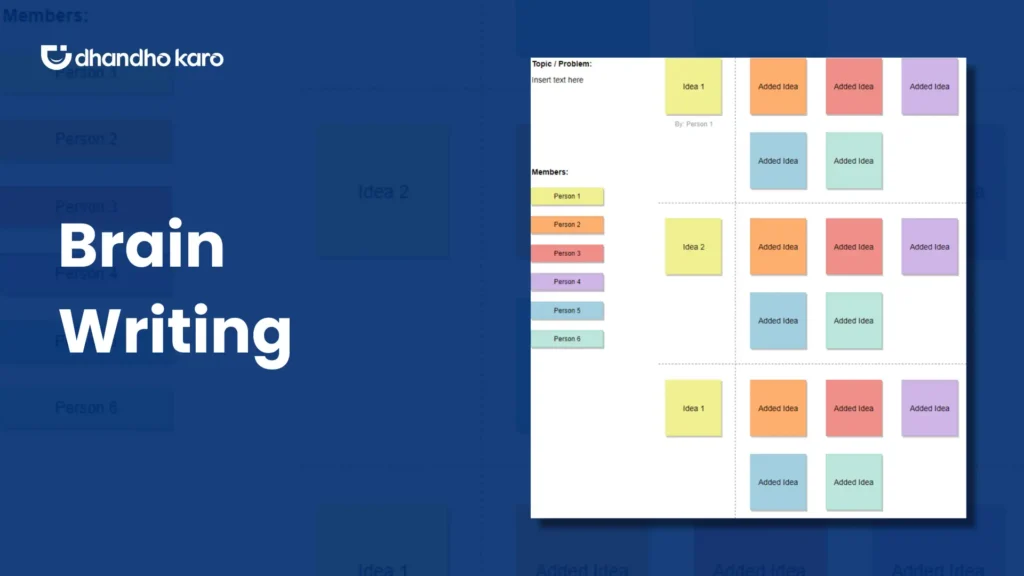
Brainwriting is one of the most effective techniques for encouraging creativity and group collaboration in a relaxed way.
In this technique, individuals are asked to write down their ideas on a piece of paper which are then shared with the group.
The best thing about brainwriting is that it eliminates one voice’s dominance over another because everyone has an equal opportunity to share their ideas.
introverts love such a kind of brainstorming technique because it does not require them to speak or interact with anyone. They can simply write down their ideas or thoughts on paper and share them with others.
Brainwriting brainstorming example
Here’s how brainwriting works:
- Get a piece of paper and pen for each person
- Write down your ideas
- Pass your paper to the person sitting next to you
- Read the ideas on the paper and add your thoughts or opinions
- Repeat it until everyone gets a turn
- Collect all the papers
4. Role storming

Another fun way to conduct brainstorming is by using the role-storming technique.
Role-storming is a brainstorming technique that helps a team in coming up with innovative ideas. The major goal here for individuals is to gain a different perspective which will help them solve a specific problem from a different point of view.
In role-storming, participants take on different personas and brainstorm as if they were that character. This helps them think in a way they never thought about and thus increases their innovation.
Furthermore, team members in an organization may come from diverse backgrounds and hold opposing viewpoints. Role-storming allows each individual to gain new perspectives and opinions, which expands their knowledge.
In this technique, the participant adopts the targeted person’s personality and overall character and imagines how they would act in X situation.
Role storming example
A great example of when role-storming can be used is when starting a business.
So, before starting a business, everyone tries to search and determine whether X problem exists to turn it into a business. Role-storming can help you with this.
You can character yourself as a customer of the business you want to start and think like a customer to improve things.
5. Stepladder technique
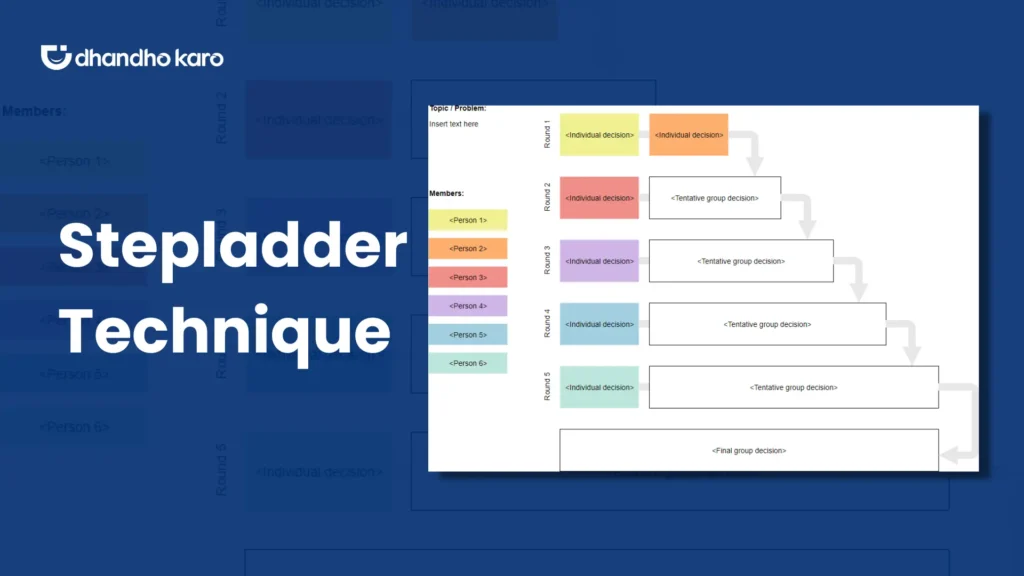
Stepladder is a creative brainstorming technique that encourages each member to participate. It is a technique that has been used successfully since the 1990s for generating innovative ideas.
- In this technique, the facilitator starts by communicating a problem to the entire group.
- Next, all team members are asked to leave the room, except for two.
- The two team members present in the room discuss their ideas and opinions on how to solve the problem.
- Once they have finished, a third member is called into the room to share his or her thoughts.
- The fourth, fifth, sixth, and so on members are called sequentially until each one is called.
The beauty of this technique is that it encourages the team’s collective creativity. By gathering ideas from each member and expanding on them, the entire group works as a team to generate even better ideas that appeal to everyone.
Stepladder brainstorming example
Stepladder is a fun way for teams to generate ideas that eliminate shyness and introversion.
A great example of when stepladder brainstorming can be used is when a company is looking to come up with new product ideas. By encouraging each member to share their ideas and building on them, the company can get a wide range of product ideas with high potential.
6. Rapid ideation

According to Parkinson’s law, “work expands to fill the time available for completion.” That means a person who can complete a task in 8 hours can complete the same task in 3 hours if the deadline is nearing.
Rapid ideation brainstorming is a technique that works somewhat similarly to Parkinson’s law.
Under this technique, all the team members are asked to generate as many ideas as they can within a given time limit to boost their productivity. The key here is to eliminate critical thinking and judgment to generate as many ideas as possible in a short amount of time.
Rapid ideation brainstorming example
Rapid ideation is a powerful technique for generating a large number of ideas in a short amount of time.
An example of rapid ideation brainstorming could be for a company that is looking for name ideas for a new product. During the brainstorming session, the facilitator may ask all the team members to come up with as many creative ideas as possible within 10 minutes. After 10 minutes, the facilitator can then filter all the names that can suit the product.
7. Round-robin brainstorming

Round robin is an effective brainstorming technique that is often used to encourage group participation from all members.
In this technique, all team members sit in a circle and each member takes turns contributing ideas and sharing their opinions without interruption from others.
The facilitator brings out a request for ideas on a specific topic and asks each team member to share their thoughts. Each member present in the room has to contribute at least once before anyone can contribute a second idea or criticism.
The participants who feel their ideas were already said may get time to think and come up with another idea that has not yet been shared.
Round-robin brainstorming example
An example of when round-robin brainstorming can come in handy is when you are looking for new product ideas for your company.
The facilitator can begin the session by keeping “product ideas” as the central topic and asking each participant to share their ideas. After each member has contributed an idea, the facilitator can ask other members to comment on other ideas. This will be extremely beneficial in developing a great product idea that is built on several ideas.
8. Reverse brainstorming

Reverse brainstorming is an unusual brainstorming technique that works very differently from the others.
That is because the participant in reverse brainstorming tries to think backward. In other words, the participant considers how he might cause problems rather than solve them. The main goal behind such brainstorming is to be prepared for certain problems ahead of time.
By forcing yourself to think of ways to make the problem worse, you can see things from a different perspective and come up with ideas you wouldn’t have thought of otherwise.
Reverse brainstorming is a fun way to approach a problem that often results in increased creativity and better problem-solving.
Reverse brainstorming example
Here is an example of reverse brainstorming:
Assume you’re trying to increase sales for your company. With reverse brainstorming, you would start off by thinking about the ways you can “worsen your sales” instead of “increasing it”. You would ask yourself “how can I decrease my sales?” A common response to this question could be “by terminating the use of X promotional channel,” “by reducing the number of salespeople,” and so on. This reverse thinking provides you with an idea of what you MUST avoid for increasing your sales.
9. Brain netting
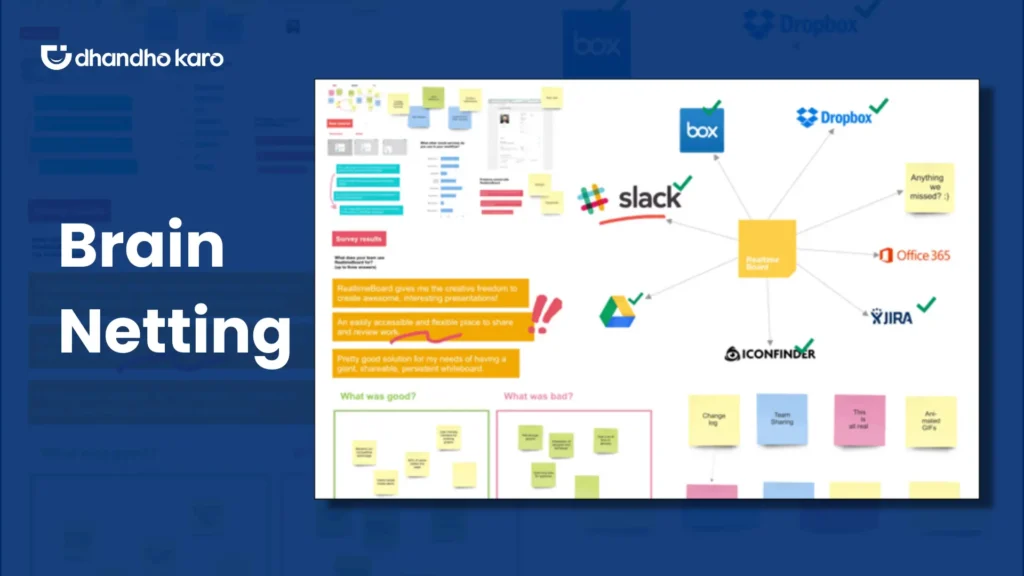
Nowadays organizations are increasingly hiring people from different locations to work remotely. However, because these employees are from various locations, they have different time zones. It is difficult for a team to conduct a brainstorming session in such circumstances. That is when they employ brain netting.
Brain netting is a modern brainstorming technique in which team members from various locations collaborate in a session through the use of virtual collaboration software.
Even if the team includes members from different time zones, they can participate in the session by using tools such as Google Docs, where the facilitator can submit a question and everyone can write down their responses. The team decides which idea to pursue after everyone has written down their ideas.
Brain netting brainstorming example
Let’s say your company is based in the United States and your employees are from various countries such as Australia, India, and Canada.
Of course, because each location has different time zones, you can’t work on a brainstorming session at the same time. In such cases, you can create a Google doc, write down the problem you want to solve, and wait for others to contribute ideas.
10 best brainstorming tools for businesses & entrepreneurs
Now let us discuss some of the best brainstorming tools that you can use for your business.
Here is a list of some of the best brainstorming tools:
1. Xmind
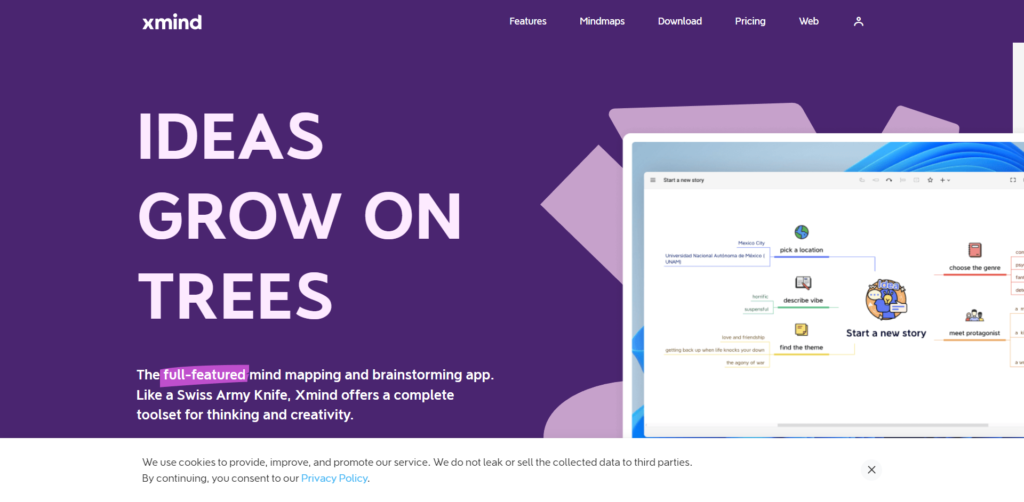
If you are looking for a brainstorming tool that can help you organize your ideas, Xmind might be the tool for you.
Basically, Xmind is a mind mapping software that helps you visually structure and organize your thoughts and ideas using mind maps. The simple interface of the tool allows you to quickly create nodes and sub-nodes, as well as add text, images, links, and attachments.
With Xmind you can create mind maps, flowcharts, diagrams, and other visual representations of your ideas. You can also share these ideas with your team together in real-time to brainstorm more effectively.
Features
- Brace map
- Presenter view
- Audio notes
- Logic chart
- Tree table structure
Starting price: Start for free. The paid plan starts at $5/month paid annually.
2. Aha!
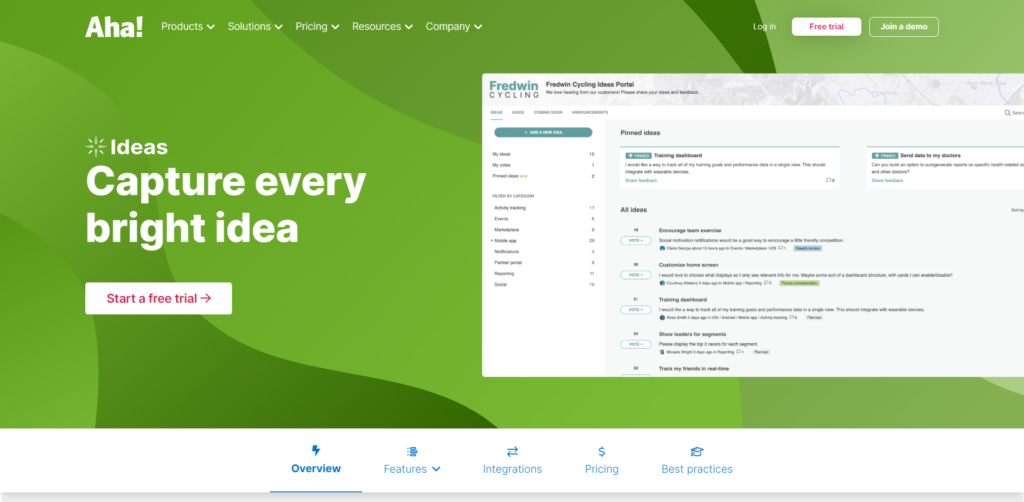
Aha! Is an all-in-one brainstorming online tool that is popular for its amazing features and ease of use.
The brainstorming tool allows you to collect and collaborate your ideas and product concepts with your team to get feedback and suggestions from various sources in real-time. The proxy voting encourages sales personnel to share ideas that customer demand to generate better ideas.
The platform provides numerous features such as customizable templates, roadmaps, tracking progress, and reports to assist businesses in communicating their product vision.
Features
- Record sessions
- Polls
- Feedback polls
- CSV importation
- Proxy voting
Starting price: Start for free. Paid plan starts at $8/month paid annually.
3. MindMeister
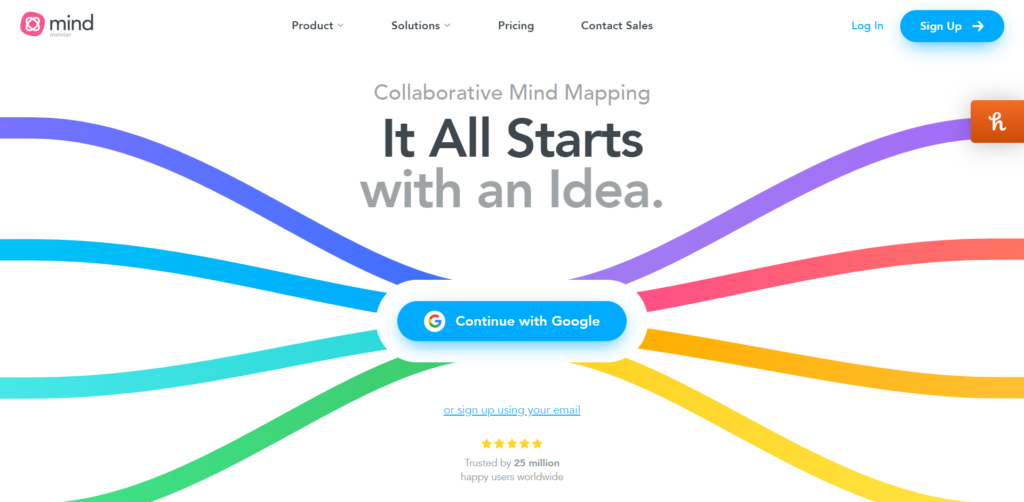
MindMeister is undoubtedly one of the most popular brainstorming tools used by various businesses for coming up with creative ideas.
It is an online brainstorming tool that enables you to create mind maps and branch them out into subtopics and related ideas, to create a web of interconnected thoughts. This helps you see connections between ideas you might not have noticed otherwise.
Furthermore, you can either start with a blank slate and add ideas as they come to you, or you can use one of the many templates available to jump-start your creativity. The tool also lets users add participants, so you can collaborate with your team in real time.
Features
- Custom style of themes
- Integration
- Secure privacy protections
- Easy export and sharing
- Map layouts
Starting price: Start for free. The paid plan starts at $3.49/month.
4. Bubbl.us
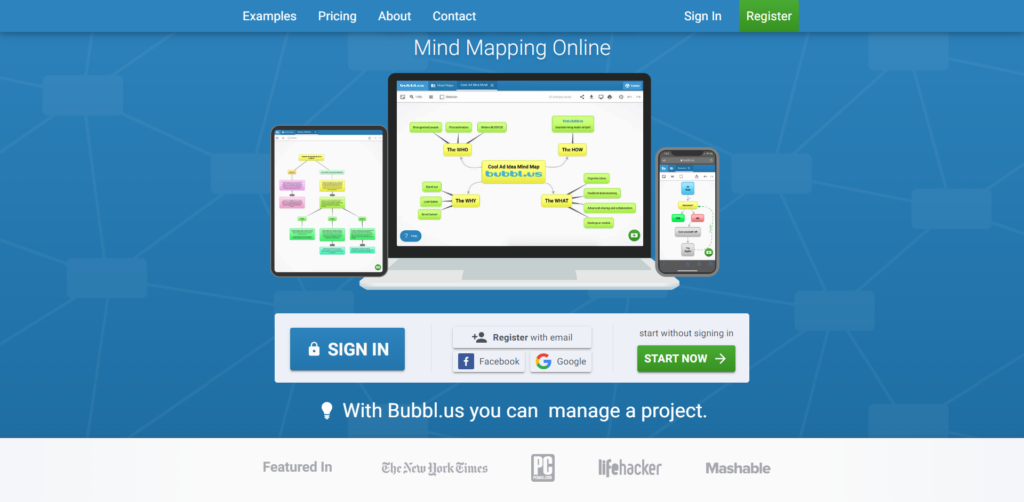
Bubbl.us is an online brainstorming and mind-mapping tool that helps you create and organize interactive diagrams with ease.
The simple interface makes it easy for you to include a thought just by clicking the bubble on the screen. You can customize the size of each bubble to make your diagram visually appealing and easy to read. You can also convert your diagrams into other formats such as PDFs.
Furthermore, the platform helps you collaborate in real time by allowing you to share your diagram with your team, making it an excellent brainstorming tool.
Features
- One-click presentation
- Easy sharing
- JPG and PNG supporting files
- Browser based
- Distraction free editing
Starting price: Start for free. Paid plan starts at $4.91/month.
5. Scapple

If you’ve heard about Scapple before, you probably know how amazing this brainstorming tool is.
Scapple is a brainstorming and mind-mapping tool that lets you jot down your thoughts and ideas in a totally free-form way. It is like your digital piece of paper that enables you to take notes on every idea you get and create nodes to connect the related ones with lines and arrows.
You can easily move things around and reorganize your thoughts as much as you want, making it one of the best brainstorming platforms in terms of its ease of use.
Features
- Full-screen mode
- Drag and drop functionality to connect ideas
- Stack notes column
Starting price: $16.47/month
6. Lucidchart
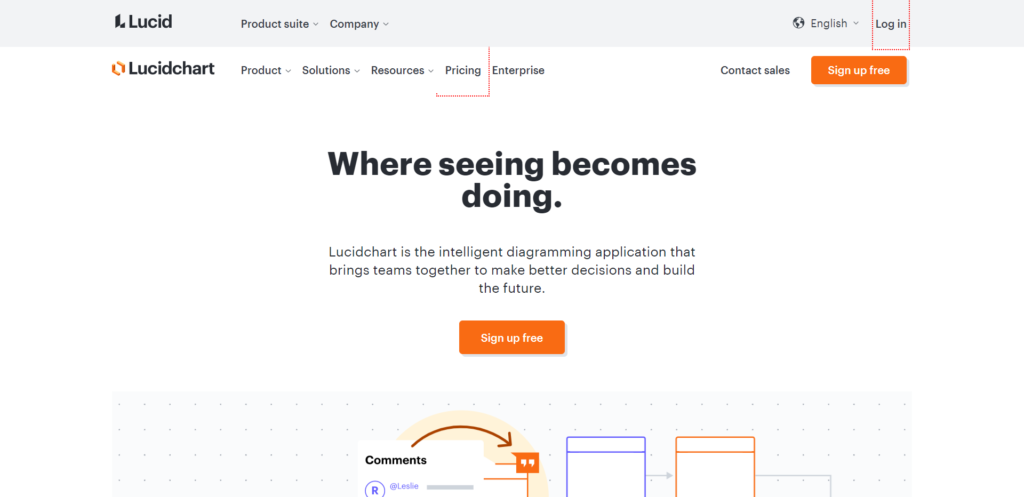
Lucidchart is another fantastic brainstorming tool that can help you visualize your ideas and bring them to life.
The platform provides a canvas for you to sketch out your thoughts and ideas in a logical way, and comes with a drag-and-drop interface that makes it easy to add shapes, arrows, and text to your canvas.
Furthermore, you can also collaborate with your team in real-time making it easier for you to brainstorm ideas.
Features
- Optimize business processes.
- Visualize technical systems.
- Brainstorm with remote teams.
- Design a superior user experience.
- Plan and deploy new features faster.
Starting price: Start for free. The paid plan starts at $7.95/month.
7. Ideanote
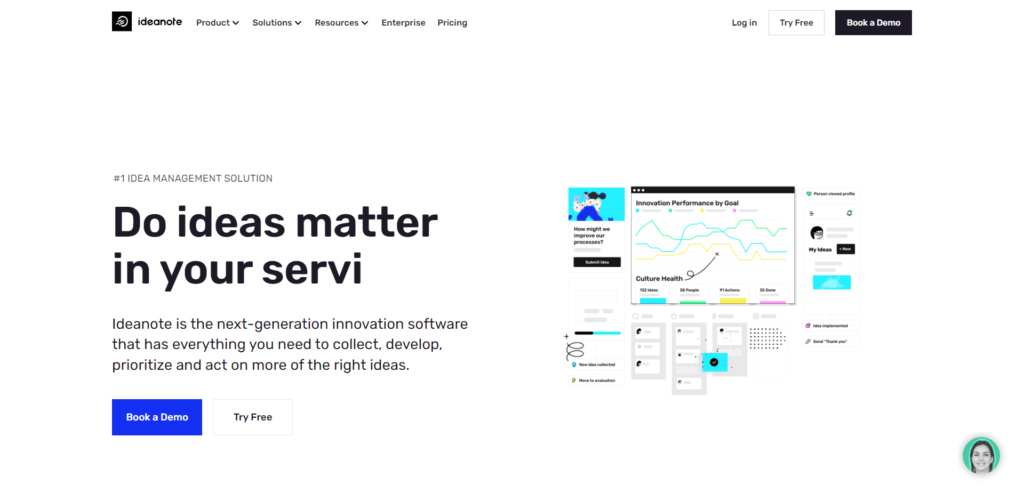
If you’re in search of a brainstorming tool that can help you generate innovative ideas, Ideanote is the one for you.
Ideanote is a user-friendly brainstorming platform that allows you to capture, develop, and share ideas with your team. The platform comes with a variety of features such as creating boards, adding tags, and categorizing ideas to make it easier for anyone to brainstorm ideas.
Whether you’re working on a marketing campaign, a product launch, or a creative project, Ideanote can adapt to your needs.
Features
- Cover images
- Idea collection templates
- Idea widget
- Anonymity
- Shareable links
Starting price: Start for free limited to 10 members. Paid plan starts at $49/month.
8. Coda
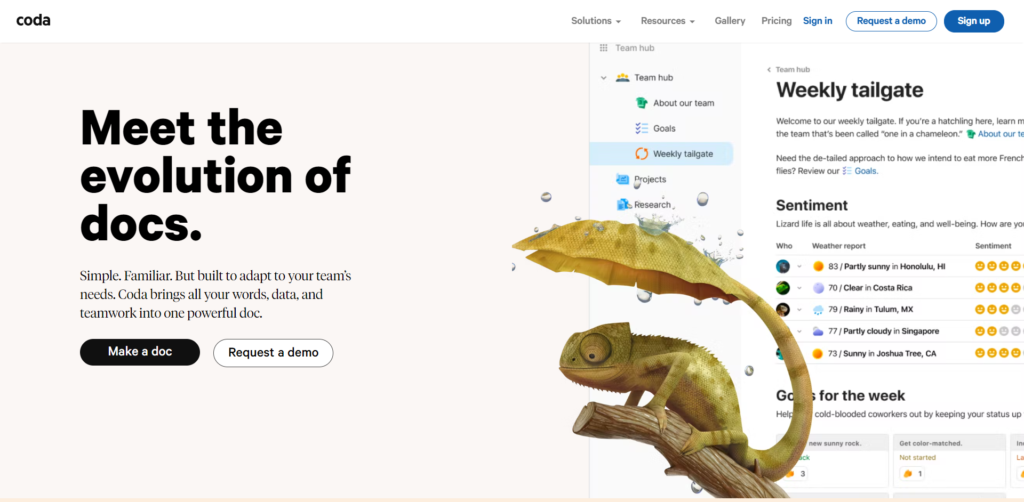
Coda is a versatile online platform that you can use for your online brainstorming purposes.
The flexible tool allows you to collaborate and brainstorm ideas, using a collection of strong building blocks. You can either create a document from scratch and add your content, or use the platform’s pre-built templates.
Furthermore, you can also invite your team members to collaborate on a project and gather feedback.
Features
- Project tracker
- Voting
- Project workback
- OKR tracker
- Meeting notes
Starting price: Start for free. The paid plan starts at $10/month.
9. Wisemapping

It’s hard to get all of your ideas out of your head and onto paper in a way that makes sense. That’s where Wisemapping comes in.
Wisemapping is a free online mind mapping tool that lets you organize your thoughts and ideas in an effective manner. The simple tool excels in teamwork, collaborative planning, and note-taking.
It’s a free and open source web mind mapping solution allowing you to access mind maps from anywhere in the world.
Features
- Integration with linking facility
- Open source software
- Embedding feature
- Collaboration
- Exportation of PVG, SNG, and JPG
Starting price: Start for free.
10. Whimsical

Whimsical is an AI-based brainstorming and mind mapping tool that helps users to visually organize their ideas and collaborate with others. It provides a range of features that enable users to create diagrams, wireframes, flowcharts, and mind maps.
Whimsical leverages AI technology to suggest relevant ideas and connections as users brainstorm and create their diagrams.
One of the key benefits of Whimsical is its ability to create diagrams automatically based on user instructions. For example, if a user wants to create a flowchart, they can simply input the steps and decisions in a natural language format, and the AI-based tool will create the flowchart automatically.
This feature saves users time and effort, as they don’t need to spend hours creating diagrams manually. Instead, they can focus on their ideas and let the AI-based tool do the heavy lifting.
Overall, Whimsical is an intuitive and user-friendly tool that leverages AI technology to help users create diagrams quickly and easily. Its range of features and flexibility make it an ideal choice for individuals and teams looking to collaborate and organize their ideas visually.
Features
- A wide range of templates and design tools for creating diagrams, wireframes, and flowcharts.
- Collaboration tools that allow multiple users to work on the same diagram in real-time.
- Commenting and chat features to communicate with team members and provide feedback.
- Export and import features for sharing diagrams with other team members or external stakeholders.
- Integration with other popular tools such as Slack, Trello, and Jira.
Starting price: Start for free. The paid plan starts at $12/month
Tips on how to brainstorm ideas
Congratulations, you now know some of the best brainstorming techniques that you can use. However, simply knowing the techniques is not enough. To ensure that your brainstorming session becomes a success, keep the following tips in mind.
Simply knowing everything about brainstorming is not enough. To ensure that your brainstorming session becomes a success, keep the following tips in mind.
Tip 1. Set clear goals
When conducting a brainstorming session, it is important to ensure that all the members of the team can understand what they must aim for.
To help each individual prepare and participate more efficiently, you must set up clear goals for what problems to solve and the base of your brainstorming session. This allows them to direct their attention and efforts in the right direction.
Tip 2. Give time to prepare
Conducting a brainstorming session without informing the team members may not be the best idea because it reduces the amount of creativity that would otherwise be created.
Inform your team members about the topic on which you will conduct brainstorming at least one day before the session so they have enough time to prepare.
Tip 3. Focus on quantity first
When it comes to brainstorming, the general rule of thumb is “quantity over quality” rather than “quality over quantity”.
When brainstorming, you should generate as many ideas as possible, no matter how silly or useless they are, because even the most ridiculous ideas can become the next big thing.
So, the next time you hold a brainstorming session, don’t be concerned about the quality of your ideas; instead, try to generate as many as possible, because the more ideas you have, the more options you have.
Tip 4. Avoid criticism
Criticism kills a person’s creativity because it prevents them from thinking outside the box. That is why you must avoid any form of criticism during your brainstorming session and allow people to express themselves freely.
Create an environment in which each member feels free to share their ideas without fear of being judged by others.
Tip 5. Encourage everyone to contribute
Some people may be afraid to share their ideas confidently in front of their team. In such cases, it is critical to encourage each member to participate and contribute their ideas without hesitation.
Give everyone an equal opportunity to speak up and share whatever thoughts come to mind.
Tip 6. Combine ideas
It is important that you don’t limit yourself to just one idea during a brainstorming session. Team members may share ideas that appear silly at the time, but when combined with the ideas of other team members, they may turn out to be the best. As a result, you must always be prepared to take on two or three ideas and combine them to improve them.
Tip 7. Follow-up
It’s not over once you’ve completed your brainstorming session. There is some more work to be done.
Following up on the ideas generated during your brainstorming session is one of the most important brainstorming tips. Take the time to go over the ideas with your team and decide which ones are worth pursuing and which are not. You can also check in on a regular basis to see how your ideas are progressing.
FAQs related to brainstorming
-
When to use brainstorming techniques?
Brainstorming techniques are generally used when the business either needs to generate ideas for a future goal or solve an existing problem.
-
What are the benefits of brainstorming?
Here are a few benefits of brainstorming:
– Generate ideas that could turn out to be the next big thing
– Effectively solve business problems
– Sparks creativity
– Promotes team building
– Helps look at a problem from different perspectives -
What are the challenges of brainstorming?
Here are a few challenges of brainstorming:
– Peer pressure
– People can get uncomfortable
– Difficulty when working remotely
– Personality differences
Conclusion
So there you have it, the complete guide to brainstorming, along with some additional tips! It’s now your turn to put these tips and techniques to use and make your brainstorming session a success. Just remember to keep an open mind and allow everyone to freely share their ideas.

